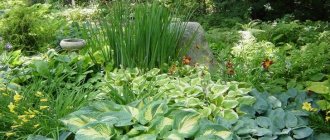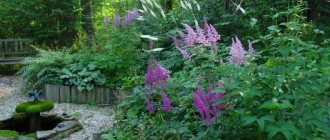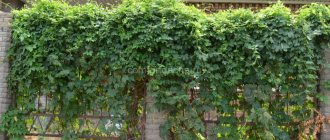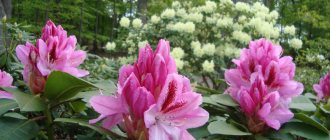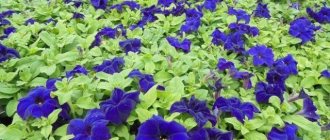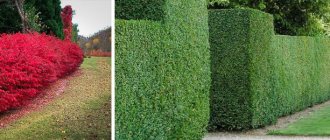The dream of many gardeners is to fill their garden with beautiful plants. But what about shady corners, in which most popular cultivated plants simply cannot grow normally? So what to fill the flower garden in the shade with so that it becomes a harmonious addition to the landscape design.
What to plant in a flowerbed in the shade: a selection of plants for planting in a shady area of the site
In almost any landscaped area there are places where shadow dominates.
For example, under the canopy of trees, near blind fences or northern walls of buildings. The sun appears here extremely rarely and quickly disappears, leaving most garden plants no chance to display their decorative qualities. Therefore, many gardeners think that planting ornamental, and especially flowering, plants in a flowerbed in the shade is the height of recklessness. Lilies do not bloom in the shade, roses look frail and get sick. So what? There are other, albeit not so luxurious and catchy, but resistant to the lack of bright lighting plants that can create the basis for a shady flower bed. Flowerbed with shade-loving perennials near the fence
Tips for caring for a shaded flower garden
A shady perennial flower garden, like any other flower garden, needs regular care. Simple rules for caring for flower beds will help maintain the attractive appearance of the flower arrangement for many years:
- Before planting, it is necessary to prepare nutrient soil. Adding compost will help provide a supply of nutrients for young plants to grow well.
- After planting, the surface of the flowerbed is mulched. This will help protect the flower garden from the spread of weeds. In a dry area, reduce the evaporation of moisture from the upper layers of the soil.
- Regular removal of damaged shoots and dry flower stalks will help maintain the attractiveness of the composition.
- Don't forget about regular watering.
- Feeding with fertilizers or folk remedies will help improve its decorative qualities.
The shade will not hurt when setting up a flower bed in a summer cottage. A wide variety of shade-tolerant plants will allow you to create a unique project that will be an excellent decoration for any shady corner.
Content
Initially, if you decide to plant a flowerbed in the shade, you need to assess the degree of illumination of the selected area. It’s one thing if the future flower garden is located on the north side of the house, where there is no direct sunlight, but there is more than enough scattered rays. And it’s completely different if we look at the thick shadow under a tree, where even grass has difficulty growing.
The gradation of zones according to the degree of illumination is quite arbitrary; in some sources (including foreign ones) it is presented as follows:
- sunny area - more than 6 hours of direct sunlight, several of which occur during the midday hours;
- partial shade – 4-6 hours of direct sunlight received in the morning or evening;
- shade – 1-4 hours of direct sunlight. This same niche can include areas where the sun penetrates through the foliage of trees (openwork shadow), or does not penetrate at all, but there is a lot of diffused light (for example, near the north side of the house);
- deep shade – up to 1 hour of direct sun.
Shadow representatives of the plant world
The most difficult living conditions are for plants planted in the “shade” and “deep shade” zones. Therefore, flower beds here are decorated not with wildly flowering perennials, but with more modest decorative foliage plants. They are not so spectacular, but they have the most important advantage - shade tolerance.
All plants for shady areas can be divided into 2 groups:
- shade-loving - they develop worse in the sun than in the shade: their leaves burn easily and change their natural shade. This includes most varieties of hosta, ferns, periwinkle, dodecatheon;
- shade-tolerant - these comrades only put up with the lack of light. That is, I don’t mind receiving a greater degree of insolation, but I have to be content with what I have. Prominent representatives of this group: aquilegia (catchment), astilbe, violas.
Choosing plants for deep shade
The most difficult thing is to plant a flower garden in deep shade: under old trees or between buildings. Shade-loving plants for flower bed No. 1 are ferns . They are not at all demanding on the quality and duration of lighting, and do not require scrupulous care. Ostrich, shieldweed, female nocturnal fern - all these forms of ferns, creating a voluminous background, will go well with ground cover, spring ephemerals, primroses, and hosts.
Shade-loving flowerbed with ferns and hostas
Another Spartan is the hoof . This is a ground cover plant with hoof-shaped leaves that grows best under the dense canopy of spruce and aspen. Clefthoof creates a dense green mat, so it can quickly disguise “gaps” in the flower garden.
Clefthoof is an evergreen plant, its leathery green leaves are well preserved under the snow.
Hostas can withstand dense shade , especially varieties with dense leathery leaves of green or blue shades, for example, “Queen of the Seas”, “Deep Blue Sea”, “Blue Mouse Ears”. Blue hostas are a real delight: their leaves are covered with a “waxy” coating, giving the plant a bluish or ashen tint. At the same time, most variegated hostas are sensitive to a lack of light and in deep shade can lose their color and become monochromatic.
In the foreground of the composition are blue hostas with a “waxy” coating on the leaf blades
Plants for the “shade” zone
The list of plants for this shady zone is more extensive. hostas with white, golden, and yellow borders on the leaves can take root here In June-August, hostas become not only decorative foliage, but also flowering. Flowers open on long stems in the center of the bush, which can have different colors (white, cream, purple) depending on the variety.
Periwinkle grows quickly under trees , covering the ground with dense leaves and small flowers of blue, purple, white, pink, and red shades. Among the lush carpet of periwinkle, you can plant various perennials, including hostas, ferns, and shade-tolerant herbs.
Periwinkle quickly weaves through the free space, creating an original flowering mat
Loves the shade and moist soils of the magnificent dicentra , blooming with bright pink “hearts” with a white droplet in the center. In a shady flower bed, the dicentra bush often becomes a background element, near which the main flower arrangement is placed.
Plants for semi-shaded flower beds
In partial shade, the daylily will take root, which just needs diffused lighting - it won’t disappear completely without the sun, of course, but it won’t bloom much either, but will give all its strength to the leaves.
Next to daylilies, you can plant perennial irises, which are suitable for any soil.
Even if there are stones in the flowerbed, you should not remove them - blue forget-me-nots will completely entwine the stones and create a unique landscape.
Ayuga will also cover the flowerbed with a thick blanket - it is completely undemanding in care.
Perennial beautiful phloxes will be a bright spot in a shady flowerbed. In addition, they delight with their flowering from mid-summer until autumn. And if dry weather reaches this flowerbed, it still won’t be able to overcome the phloxes. Just like winter frosts.
To create a background, pink hearts of Dicentra splendor are well suited. The bush is quite large - about a meter in height, so it is better to plant it in the background so as not to cover low-growing plants.
Rules for building a shady flower bed
Since the majority of shade-tolerant plants do not have bright inflorescences, the main emphasis when placing them in flower beds should be on the size and shape of the bushes. The basic rule of landscape combinations is: horizontal lines must be adjacent to vertical ones. That is, the wide, large leaves of some plants go well with the tall peduncles and long stems of others.
For example, broad-leaved hostas and heucheras can become spectacular neighbors in a flower garden during the flowering period. The gaps between them are filled with shade-tolerant groundcovers: periwinkle, hoofed grass, creeping tenacious - they will create a wide horizontal line in the lower tier of the flower garden.
Flowerbed under linden trees - composition for openwork shade
The loose shade under the linden trees makes it possible to build a composition of decorative foliage and flowering shade-tolerant plants. This flowerbed will be decorative all summer until late autumn. If you supplement it with spring ephemera (lilies of the valley, muscari, crocuses, hyacinths), then it will be painted with bright colors in early spring.
Flowerbed under the trees: 1 - multi-colored mountain weed, 2 - female nomad, 3 - hosta, 4 - Arends astilbe, 5 - yellow corydalis, 6 - Chinese astilbe, 7 - viola, 8 - wavy hosta, 9 - lungwort, 10 - telipteris, 11 - Volzhanka, 12 - linden
Triangular flowerbed in the shade
A multi-tiered flowerbed of an interesting shape will fill a problematic shady area between buildings or trees. In the composition, a tall Volzhanka dioecious, bordered by two ferns (ostriches), emphasizes the beauty of small inflorescences of brunnera, garden geranium and astrantia.
Triangular flower bed: 1 - ostrich, 2 - astrantia, 3 - Volzhanka, 4 - hosta, 5 - flat-petaled geranium, 6 - brunnera
Flowerbed of shade-loving perennials
This shade-loving flowerbed consists entirely of decorative deciduous unpretentious perennials. Even in deep shade, in the depths of the garden or under dense trees, it will not lose its decorative effect. However, in particularly problematic shady areas of the hosta, wavy may lose its white border.
Selection of plants depending on the degree of shading of the site
You shouldn’t get upset ahead of time because there are a lot of shady places on a small summer cottage where you want to make a full-fledged vegetable garden and arrange a beautiful flower bed. It's better to look at this situation from the other side. For example, in the summer heat in the shade you can hide from the sun's rays. And shade-loving plants, the range of which is no less than that of the light-loving representatives of the flower garden, will help fill these places with bright colors and a pleasant aroma. A shady flower bed consisting of perennials will decorate any yard.
When selecting plants for a future composition, you should pay attention to the following characteristics of the site:
- Location relative to the sides of the horizon.
- Source of shadow.
- Duration and intensity of sunlight.
All these indicators directly affect shading. Illumination is influenced by the height of the sun, the duration of daylight hours and objects that create shadows. In most cases, deep shade maintains high humidity and little noticeable temperature fluctuations during the day. This must also be taken into account.
What plants are suitable for deep shade?
Most often, deep shading can be seen in areas on the north side, which are in the shadow of outbuildings or under mature trees with a spreading, dense crown. For example, apple tree, dense spruce, oak. The sun's rays penetrate here for only 2-3 hours in the early morning, and the remaining time the plants are in the shade. A microclimate with high humidity may suit the following plants:
- fern;
- host;
- sorrel;
- lily of the valley;
- purchased;
- periwinkle;
- geranium;
- liverwort;
- hoof;
- hellebore;
- elecampane;
- oak anemone.
Is a shadow always a shadow?
A flower garden in a shady place can be formed from plants of 2 categories:
- Shade-tolerant plants . Can tolerate lack of sufficient sunlight. They would be happy to grow in the sun, but they will also thank you for a place in a shady flowerbed. I am sure that these representatives are well known to you, for example, astilbe, columbine and viola.
- Shade-loving flowers and shrubs . They feel uncomfortable under the sun; their leaves burn and fade very quickly. These include various hostas, the fern family, and periwinkle.
